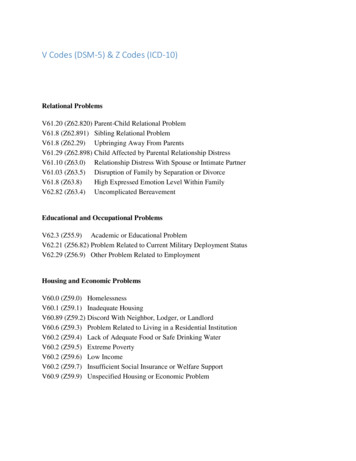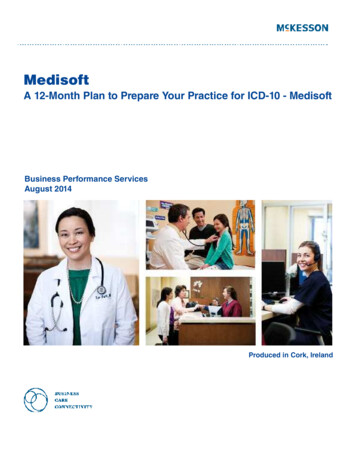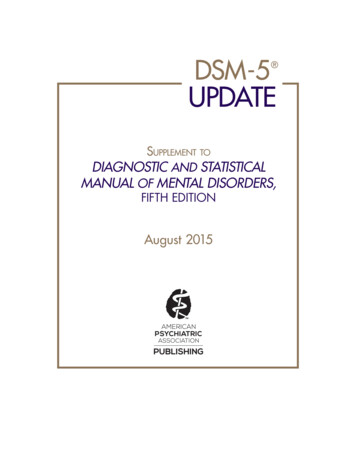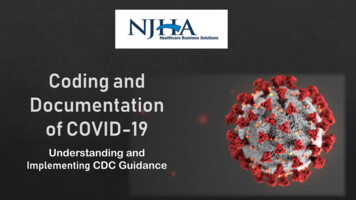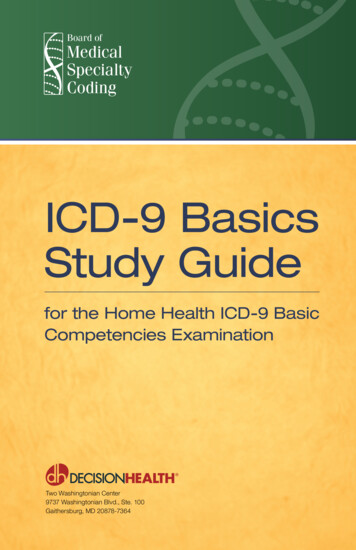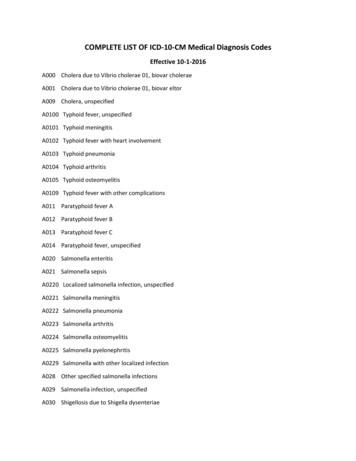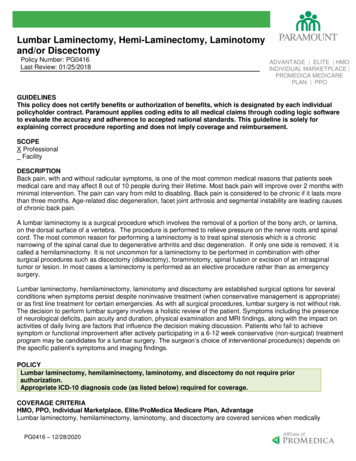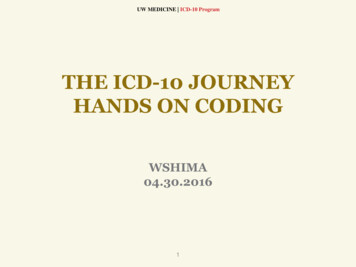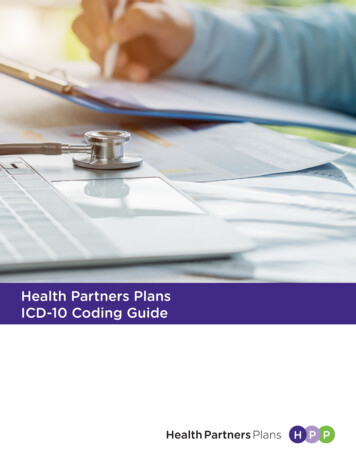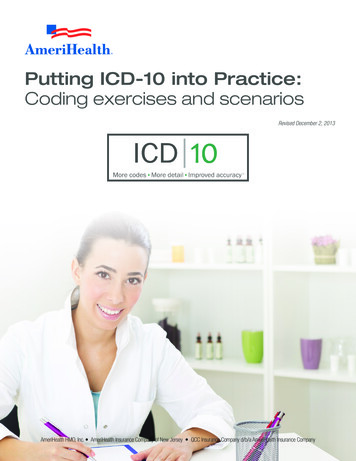
Transcription
Putting ICD-10 into Practice:Coding exercises and scenariosRevised December 2, 2013AmeriHealth HMO, Inc. AmeriHealth Insurance Company of New Jersey QCC Insurance Company d/b/a AmeriHealth Insurance Company
Putting ICD-10 into Practice:Coding exercises and scenariosTable of ContentsPartners in Health UpdateSM editionPageJanuary 20133February 20135March 20137April 20139May 201311June 201313July 201315August 201317September 201319October 201321November 201323December 201325
Putting ICD-10 into Practice:Coding exercises and scenariosThe ICD-10 Spotlight: Know the codes feature that appeared in Partners in Health Update throughout 2012 wasdesigned to communicate various coding conventions, general guidelines, and chapter-specific guidelines in ICD-10.These conventions and guidelines are rules and instructions that must be followed to classify and assign the mostappropriate code. As with ICD-9, adherence to these guidelines is required under the Health Insurance Portability andAccountability Act (HIPAA).This year, we are introducing a new feature called Putting ICD-10 into Practice: Coding exercises and scenarios. Eachmonth this feature will help you put the new guidelines and conventions you learned about last year into practice.If needed, use the ICD-10 Spotlight: Know the codes booklet for assistance with these exercises. An answer key isprovided below so you can verify if your answers are correct. In addition, a list of code narratives is included to describeeach ICD-10 code.Coding exercisesCode the following conditions according to ICD-10 coding conventions and guidelines:1. Varicose vein of heel and mid-foot with presence of ulceration and swelling2. Premature menopause with headache3. Acute myocardial infarction of the anterolateral wall4. Subsequent encounter for obesity resulting from the prescription drug Tryptanol 5. Crohn’s disease of ileum with rectal bleeding and abscess6. Bilateral central corneal ulcer7. Severe generalized abdominal pain with abdominal rigidity8. Female with bilateral breast cancer of lower outer quadrant9. Acute nonsuppurative otitis media of the right ear10. Initial encounter for concussion and edema of the thoracic spine11. Initial encounter for third degree burn of the right thigh by gasoline to fifteen percent of the total body surface areaCoding scenarioCode the following scenario according to ICD-10 coding conventions and guidelines:While chopping vegetables in the kitchen of his mobile home for the local food bank’s Thanksgiving dinner,John Doe lacerated his right thumb causing injury to the nail.S61.111A, W26.0xxA, Y92.020, Y93.G1, Y99.2,Answer to coding scenario:10) S24.0xxA 11) T24.711A, T32.10, T52.0x1A1) I83.224 2) E28.310 3) I21.09 4) E66.1, T43.015D 5) K50.011, K50.014 6) H16.013 7) R10.0 8) C50.511, C50.512 9) H65.191Answers to coding exercises:continued on the next pageJanuary 2013 Partners in Health UpdateSM3www.amerihealth.com/providers
Putting ICD-10 into Practice:Coding exercises and scenariosNarrativesThe following are the corresponding code narratives for each of the ICD-10 codes in the answer key:I83.224: Varicose veins of left lower extremity with both ulcer of heel and midfoot and inflammationE28.310: Symptomatic premature menopauseI21.09: ST elevation myocardial infarction (STEMI) involving other coronary artery of anterior wallE66.1: Drug-induced obesityT43.015D: Adverse effect of tricyclic antidepressants, subsequent encounterK50.011: Crohn’s disease of small intestine with rectal bleedingK50.014: Crohn’s disease of small intestine with abscessH16.013: Central corneal ulcer, bilateralR10.0: Acute abdomenC50.511: Malignant neoplasm of lower-outer quadrant of right female breastC50.512: Malignant neoplasm of lower-outer quadrant of left female breastH65.191: Other acute nonsuppurative otitis media, right earS24.0xxA: Concussion and edema of thoracic spinal cord, initial encounterT24.711A: Corrosion of third degree of right thigh, initial encounterT52.0x1A: Toxic effect of petroleum products, accidental (unintentional), initial encounterT32.10: Corrosions involving 10%–19% of body surface with 0%–9% third degree corrosionY93.G1: Activity, food preparation and clean upW26.0xxA: Contact with knife, initial encounterS61.111A: Laceration without foreign body of right thumb with damage to nail, initial encounterY92.020: Kitchen in mobile home as the place of occurrence of the external causeY99.2: Volunteer activityFor additional information related to the AmeriHealth transition to ICD-10, please visit www.amerihealth.com/icd10. Onthis site you will find examples of how ICD-9 codes will translate to ICD-10 codes in the ICD-10 Spotlight: Know thecodes booklet.January 2013 Partners in Health UpdateSM4www.amerihealth.com/providers
Putting ICD-10 into Practice:Coding exercises and scenariosThe ICD-10 Spotlight: Know the codes feature that appeared throughout Partners in Health Update last year wasdesigned to communicate various coding conventions, general guidelines, and chapter-specific guidelines in ICD-10.These conventions and guidelines are rules and instructions that must be followed to classify and assign the mostappropriate code. As with ICD-9, adherence to these guidelines is required under the Health Insurance Portability andAccountability Act (HIPAA).As announced in the January 2013 edition of Partners in Health Update, we have introduced a new feature called PuttingICD-10 into Practice: Coding exercises and scenarios. Each month this feature will help you put the new guidelines andconventions you learned about last year into practice. If needed, use the ICD-10 Spotlight: Know the codes bookletfor assistance with these exercises. An answer key is provided below so you can verify if your answers are correct. Inaddition, a list of code narratives is included to describe each ICD-10 code.Coding exercisesCode the following conditions according to ICD-10 coding conventions and guidelines:1. Borderline glaucoma2. Congestive heart failure due to hypertension3. HIV positive status without symptom4. Urinary frequency5. Morbid obesity with a BMI of 42 in an adult6. Congenital red cell aplastic anemia7. Cleft palate involving both the soft and hard palate with bilateral cleft lip8. Severe persistent asthma with acute exacerbation9. Fatigue fracture of vertebra, lumbar region, and subsequent encounter for fracture with delayed healing10. Interstitial cystitis due to E. coli with hematuria11. Sleep-related teeth grinding12. Non-conclusive HIV-test finding in infantsCoding scenarioCode the following scenario according to ICD-10 coding conventions and guidelines: Jane and John Doe were shopping at the mall the day after Thanksgiving to take advantage of the sales. While rushingfor the newest iPhone, John fell down the stairs. Thankfully, John sustained only minor abrasions to his right elbow.S50.311A, W10.9xxA, Y92.59Answer to coding scenario:12) R751) H40.001 2) I11.0 3) Z21 4) R35.0 5) E66.01, Z68.41 6) D61.01 7) Q37.4 8) J45.51 9) M48.46xG 10) N30.11, B96.20 11) G47.63Answers to coding exercises:continued on the next pageFebruary 2013 Partners in Health UpdateSM5www.amerihealth.com/providers
Putting ICD-10 into Practice:Coding exercises and scenariosNarrativesThe following are the corresponding code narratives for each of the ICD-10 codes in the answer key for the codingexercises and coding scenarios:H40.001: Preglaucoma, unspecified, right eyeI11.0: Hypertensive heart disease with heart failureZ21: Asymptomatic human immunodeficiency virus [HIV] infection statusR35.0: Frequency of micturitionE66.01: Morbid (severe) obesity due to excess caloriesZ68.41: Body mass index (BMI) 40.0 – 44.9, adultD61.01: Constitutional (pure) red blood cell aplasiaQ37.4: Cleft hard and soft palate with bilateral cleft lipJ45.51: Severe persistent asthma with (acute) exacerbationM48.46xG: Fatigue fracture of vertebra, lumbar region, subsequent encounter for fracture with delayed healingN30.11: Interstitial cystitis (chronic) with hematuriaB96.20: Unspecified Escherichia coli [E. coli] as the cause of diseases classified elsewhereG47.63: Sleep-related bruxismR75: Inconclusive laboratory evidence of human immunodeficiency virus [HIV]S50.311A: Abrasion of right elbow, initial encounterW10.9xxA: Fall (on) (from) unspecified stairs and steps, initial encounterY92.59: Other trade areas as the place of occurrence of the external causeFor additional information related to the AmeriHealth transition to ICD-10, please visit www.amerihealth.com/icd10.On this site you will find examples of how ICD-9 codes will translate to ICD-10 codes in the ICD-10 Spotlight: Know thecodes booklet. In addition, you will find examples of ICD-10 coding exercises and scenarios in the Putting ICD-10 intoPractice: Coding exercises and scenarios booklet.February 2013 Partners in Health UpdateSM6www.amerihealth.com/providers
Putting ICD-10 into Practice:Coding exercises and scenariosIn preparation for the transition to ICD-10, each month AmeriHealth will include an article called Putting ICD-10 intoPractice: Coding exercises and scenarios in Partners in Health Update. This feature will help you put the new guidelinesand conventions you learned about last year into practice. If needed, use the ICD-10 Spotlight: Know the codes bookletfor assistance with these exercises. An answer key is provided below so you can verify if your answers are correct. Inaddition, a list of code narratives is included to describe each ICD-10 code.Coding exercisesCode the following conditions according to ICD-10 coding conventions and guidelines:1. Routine infant or child health check2. Acquired loss of teeth due to trauma, partial3. Influenzal myocarditis4. Elevated fasting triglycerides5. Hungry bone syndrome6. Primary open-angle glaucoma, moderate stage in left eye and mild stage in right eye7. Dorsal somatic dysfunction8. Invasive ductular carcinoma of breast, completely excised9. Decompensated COPD with (acute) exacerbation10. Concussion without loss of consciousness, initial encounter with neck painCoding scenarioCode the following scenario according to ICD-10 coding conventions and guidelines: A 16-year-old student was at the gymnasium participating in a dancing contest to raise money for her class. Sheslipped on the gym floor and fell, injuring her left ankle. After she visited the emergency room, it was determined thatshe did not fracture her ankle. However, she did suffer a sprain to that ankle.S93.402A, W01.0xxA, Y92.39, Y93.41, Y99.2Answer to coding scenario:1) Z00.129 2) K08.419 3) J10.89 4) E78.1 5) E83.81 6) H40.11x2, H40.11x1 7) M99.01 8) C50.412 9) J44.1 10) S06.0x0A, M54.2Answers to coding exercises:continued on the next pageMarch 2013 Partners in Health UpdateSM7www.amerihealth.com/providers
Putting ICD-10 into Practice:Coding exercises and scenariosNarrativesThe following are the corresponding code narratives for each of the ICD-10 codes in the answer key for the codingexercises and coding scenarios:ICD-10 codeCode narrativeZ00.129Encounter for routine child health examination without abnormal findingsK08.419Partial loss of teeth due to trauma, unspecified classJ10.89Influenza due to other identified influenza virus with other manifestationsE78.1Pure hyperglyceridemiaE83.81Hungry bone syndromeH40.11x2Primary open-angle glaucoma, moderate stageH40.11x1Primary open-angle glaucoma, mild stageM99.01Segmental and somatic dysfunction of cervical regionC50.412Malignant neoplasm of upper-outer quadrant of left female breastJ44.1Chronic obstructive pulmonary disease with (acute) exacerbationS06.0x0AConcussion without loss of consciousness, initial encounterM54.2CervicalgiaS93.402ASprain of unspecified ligament of left ankle, initial encounterW01.0xxAFall on same level from slipping, tripping, and stumbling without subsequent striking against object,initial encounterY92.39Other specified sports and athletic area as the place of occurrence of the external causeY93.41Activity, dancingY99.2Volunteer activityFor additional information related to the AmeriHealth transition to ICD-10, please visit www.amerihealth.com/icd10.On this site you will find examples of how ICD-9 codes will translate to ICD-10 codes in the ICD-10 Spotlight: Know thecodes booklet. In addition, you will find examples of ICD-10 coding exercises and scenarios in the Putting ICD-10 intoPractice: Coding exercises and scenarios booklet.March 2013 Partners in Health UpdateSM8www.amerihealth.com/providers
Putting ICD-10 into Practice:Coding exercises and scenariosIn preparation for the transition to ICD-10, each month this section will feature an article to help you put the newguidelines and conventions you learned about last year into practice. If needed, use the ICD-10 Spotlight: Know thecodes booklet for assistance with these exercises. An answer key is provided below so you can verify if your answers arecorrect. In addition, a list of code narratives is included on the next page to describe each ICD-10 code.Coding exercisesCode the following conditions according to ICD-10 coding conventions and guidelines:1. Atrial tachycardia2. Irregular astigmatism of both eyes3. Shaken infant syndrome, initial encounter4. Painful respiration5. Neonatal esophageal reflux6. Twin pregnancy, one placenta, two amniotic sacs, third trimester with complication of gestational hypertension7. Lisping8. Subacute monocytic leukemia, in remission9. Neoplasm of uncertain behavior of the nasal cavities10. Benign carcinoid tumor of the small intestine11. Atypical chest pain due to anginaCoding scenarioCode the following scenario according to ICD-10 coding conventions and guidelines:Due to ailing health, Jane’s grandfather will be moving in with her in a few months. To understand what care is needed,Jane escorted her grandfather to his doctor appointment for the first time. The doctor told Jane that her grandfatherwas being treated for mild nonproliferative diabetic retinopathy with macular edema. He has type 2 diabetes and takesinsulin on a daily basis. He has also developed diabetic cataract in his right eye.E11.321, E11.36, Z79.4Answer to coding scenario:1) I47.1 2) H52.213 3) T74.4xxA 4) R07.1 5) P78.83 6) O30.033, O13.3 7) F80.0 8) C93.91 9) D38.5 10) D3A.019 11) R07.89, I20.9Answers to coding exercises:continued on the next pageApril 2013 Partners in Health UpdateSM9www.amerihealth.com/providers
Putting ICD-10 into Practice:Coding exercises and scenariosNarrativesThe following are the corresponding code narratives for each of the ICD-10 codes in the answer key for the codingexercises and coding scenario:ICD-10 codeCode narrativeI47.1Supraventricular tachycardiaH52.213Irregular astigmatism, bilateralT74.4xxAShaken infant syndrome, initial encounterR07.1Chest pain on breathingP78.83Newborn esophageal refluxO30.033Twin pregnancy, monochorionic/diamniotic, third trimesterO13.3Gestational (pregnancy-induced) hypertension without significant proteinuria, third trimesterF80.0Phonological disorderC93.91Monocytic leukemia, unspecified in remissionD38.5Neoplasm of uncertain behavior of other respiratory organsD3A.019Benign carcinoid tumor of the small intestine, unspecified portionR07.89Other chest painI20.9Angina pectoris, unspecifiedE11.321Type 2 diabetes mellitus with mild nonproliferative diabetic retinopathy with macular edemaE11.36Type 2 diabetes mellitus with diabetic cataractZ79.4Long term (current) use of insulinFor additional information related to the AmeriHealth transition to ICD-10, please visit www.amerihealth.com/icd10. Onthis site you will find examples of how ICD-9 codes will translate to ICD-10 codes in the ICD-10 Spotlight: Know thecodes booklet. In addition, you will find examples of ICD-10 coding exercises and scenarios in the Putting ICD-10 intoPractice: Coding exercises and scenarios booklet.April 2013 Partners in Health UpdateSM10www.amerihealth.com/providers
Putting ICD-10 into Practice:Coding exercises and scenariosThe coding exercises and scenario in this section are designed to help you put the new ICD-10 guidelines andconventions into practice. An answer key is provided below so you can verify if your answers are correct. In addition,code narratives are included on the next page to describe each ICD-10 code used in the exercises and scenario.If needed, use the ICD-10 Spotlight: Know the codes booklet for assistance with these exercises. It is available atwww.amerihealth.com/icd10.Coding exercisesCode the following conditions according to ICD-10 coding conventions and guidelines:1. Blindness (right eye), low vision (left eye)2. Hypotension due to drugs (diuretics), initial encounter3. Fecal impaction4. Irritable colon with diarrhea5. Constipation6. Allergy from cat hair7. Itch8. Rheumatoid nodule, both shoulders9. Kidney disease requiring chronic dialysis10. Kidney disease requiring chronic dialysis, non-compliant patientCoding scenarioCode the following scenario according to both ICD-9 and ICD-10 coding conventions and guidelines:Tim and Susan celebrated their wedding anniversary by making reservations at the restaurant where they had theirfirst date. They both decided to order something they have never tried before. The meal was delicious, but later thatevening Tim broke out in a rash and experienced abdominal cramping and diarrhea. Susan suspected it must havebeen something he ate and advised him to see his doctor. The physician confirmed Susan’s suspicion.ICD-9: 558.3, 693.1, 787.91, E849.6ICD-10: K52.2, L27.2, Y92.511Answer to coding scenario:1) H54.11 2) I95.2, T50.2x5A 3) K56.41 4) K58.0 5) K59.00 6) L23.81 7) L29.9 8) M06.311, M06.312 9) N18.6, Z99.2 10) N18.6, Z91.15Answers to coding exercises:continued on the next pageMay 2013 Partners in Health UpdateSM11www.amerihealth.com/providers
Putting ICD-10 into Practice:Coding exercises and scenariosNarrativesThe following are the corresponding code narratives for each of the codes in the answer key:ICD-10 codeCode narrativeExercisesH54.11Blindness, right eye, low vision left eyeI95.2Hypotension due to drugsT50.2x5AAdverse effect of carbonic-anhydrase inhibitors, benzothiadiazides, and other diuretics, initialencounterK56.41Fecal impactionK58.0Irritable bowel syndrome with diarrheaK59.00Constipation, unspecifiedL23.81Allergic contact dermatitis due to animal (cat) (dog) danderL29.9Pruritus, unspecifiedM06.311Rheumatoid nodule, right shoulderM06.312Rheumatoid nodule, left shoulderN18.6End stage renal diseaseZ99.2Dependence on renal dialysisZ91.15Patient’s noncompliance with renal dialysisScenario — ICD-10K52.2Allergic and dietetic gastroenteritis and colitisL27.2Dermatitis due to ingested foodY92.511Restaurant or cafe as the place of occurrence of the external causeScenario — ICD-9558.3Gastroenteritis and colitis, allergic693.1Dermatitis due to food taken internally787.91DiarrheaE849.6Place of occurrence, public buildingFor additional information related to the AmeriHealth transition to ICD-10, please visit www.amerihealth.com/icd10. Onthis site you will find examples of how ICD-9 codes will translate to ICD-10 codes in the ICD-10 Spotlight: Know thecodes booklet. In addition, you will find examples of ICD-10 coding exercises and scenarios in the Putting ICD-10 intoPractice: Coding exercises and scenarios booklet.May 2013 Partners in Health UpdateSM12www.amerihealth.com/providers
Putting ICD-10 into Practice:Coding exercises and scenariosThe coding exercises and scenarios in this section are designed to help you put the new ICD-10 guidelines andconventions into practice. An answer key is provided below so you can verify if your answers are correct. In addition,code narratives are included on the next page to describe each ICD-10 code used in the exercises and scenario.If needed, use the ICD-10 Spotlight: Know the codes booklet for assistance with these exercises. It is available atwww.amerihealth.com/icd10.Specialty focus: OB/GYNCoding exercisesCode the following conditions according to ICD-10 coding conventions and guidelines:1. Rupture of fallopian tube due to pregnancy2. Positive culture findings in specimens from female genital organs3. Newborn affected by breech presentation before labor4. Pregnancy of 43-year-old complicated by hypertension (2nd trimester)5. Urinary tract infection and urinary tract infection, neonatal6. Endometriosis of ovary7. Chronic vulvovaginitis8. Uterine prolapse, 1st degree and 3rd degree9. Female infertility due to tubal block10. Venereal warts due to HPVCoding scenarioCode the following scenario according to ICD-10 coding conventions and guidelines:During a night out drinking with friends, 26-year-old Jane gave birth at 30 weeks to a female infant in a taxi cab. Janedrank alcohol throughout her pregnancy despite her family and physician’s counsel. Although not confirmed, Jane’sfamily suspected she was abusing drugs as well. The infant was born with fetal alcohol syndrome and showed signs ofdrug withdrawal. The infant’s weight at birth was 3.5 pounds.*When both birth weight and gestational age of the newborn are available, both should be coded with birth weight sequenced before gestational age.Z38.1, P04.3, Q86.0, P07.16*, P07.33, P96.1Answer to coding scenario:1) O00.1 2) R87.5 3) P01.7 4) O13.2, O09.522 5) N39.0, P39.3 6) N80.1 7) N76.1 8) N81.2, N81.3 9) N97.1 10) A63.0Answers to coding exercises:continued on the next pageJune 2013 Partners in Health UpdateSM13www.amerihealth.com/providers
Putting ICD-10 into Practice:Coding exercises and scenariosNarrativesThe following are the corresponding code narratives for each of the codes in the answer key:ICD-10 codeCode narrativeExercisesO00.1Tubal pregnancyR87.5Abnormal microbiological findings in specimens from female genital organsP01.7Newborn (suspected to be) affected by malpresentation before laborO13.2Gestational (pregnancy-induced) hypertension without significant proteinuria, 2nd trimesterO09.522Supervision of elderly multigravida, 2nd trimesterN39.0Urinary tract infection, site not specifiedP39.3Neonatal urinary tract infectionN80.1Endometriosis of ovaryN76.1Subacute and chronic vaginitisN81.2Incomplete uterovaginal prolapseN81.3Complete uterovaginal prolapseN97.1Female infertility of tubal originA63.0Anogenital (venereal) wartsScenarioZ38.1Single liveborn infant, born outside hospitalP04.3Newborn (suspected to be) affected by maternal use of alcoholQ86.0Fetal alcohol syndrome (dysmorphic)P07.16Other low birth weight newborn, 1500-1749 gramsP07.33Preterm newborn, gestational age 30 completed weeksP96.1Neonatal withdrawal symptoms from maternal use of drugs of addictionPlease visit the ICD-10 section of our website at www.amerihealth.com/icd10. On this site you will find additionalinformation related to the transition to ICD-10, including frequently asked questions, examples of how ICD-9 codes willtranslate to ICD-10 codes in the ICD-10 Spotlight: Know the codes booklet, and examples of ICD-10 coding exercisesand scenarios in the Putting ICD-10 into Practice: Coding exercises and scenarios booklet.June 2013 Partners in Health UpdateSM14www.amerihealth.com/providers
Putting ICD-10 into Practice:Coding exercises and scenariosThe coding exercises and scenario in this section are designed to help you put the new ICD-10 guidelines andconventions into practice. An answer key is provided below so you can verify if your answers are correct. In addition,code narratives are included on the next page to describe each ICD-10 code used in the exercises and scenario.If needed, use the ICD-10 Spotlight: Know the codes booklet for assistance with these exercises. It is availableat www.amerihealth.com/icd10.Specialty focus: Disease of the circulatory systemCoding exercisesCode the following conditions according to ICD-10 coding conventions and guidelines:1. Atrial fibrillation, permanent2. Bradytachycardia3. Intermittent claudication4. Deep vein thrombosis, right lower extremity5. Healed myocardial infarction6. Ventricular aneurysm7. Rheumatic aortic regurgitation8. Biventricular heart failure9. Hypertensive heart failure10. Cardiomyopathy from alcohol abuseCoding scenarioCode the following scenario according to ICD-10 coding conventions and guidelines:While playing basketball with his sons, Jack began experiencing chest pain, shortness of breath, andlight-headedness. His sons rushed him to the hospital, as they suspected he was having a heart attack.The emergency department physician commended the sons for their quick response. Jack was indeedhaving a heart attack and was diagnosed with an acute non-ST anterior wall myocardial infarction.R07.9, R06.02, R42, I21.4Answer to coding scenario:1) I48.2 2) I49.5 3) I73.9 4) I82.401 5) I25.2 6) I25.3 7) I06.1 8) I50.9 9) I11.0 10) I42.6, F10.99Answers to coding exercises:continued on the next pageJuly 2013 Partners in Health UpdateSM15www.amerihealth.com/providers
Putting ICD-10 into Practice:Coding exercises and scenariosNarrativesThe following are the corresponding code narratives for each of the codes in the answer key:ICD-10 codeCode narrativeExercisesI48.2Chronic atrial fibrillationI49.5Sick sinus syndromeI73.9Peripheral vascular disease, unspecifiedI82.401Acute embolism and thrombosis of unspecified deep veins of right lower extremityI25.2Old myocardial infarctionI25.3Aneurysm of heartI06.1Rheumatic aortic insufficiencyI50.9Heart failure, unspecifiedI11.0Hypertensive heart disease with heart failureI42.6Alcoholic cardiomyopathyF10.99Alcohol use, unspecified with unspecified alcohol-induced disorderScenarioR07.9Chest pain, unspecifiedR06.02Shortness of breathR42Dizziness and giddinessI21.4Non-ST elevation (NSTEMI) myocardial infarctionPlease visit the ICD-10 section of our website at www.amerihealth.com/icd10. On this site you will find additionalinformation related to the transition to ICD-10, including frequently asked questions, examples of how ICD-9 codes willtranslate to ICD-10 codes in the ICD-10 Spotlight: Know the codes booklet, and examples of ICD-10 coding exercisesand scenarios in the Putting ICD-10 into Practice: Coding exercises and scenarios booklet.July 2013 Partners in Health UpdateSM16www.amerihealth.com/providers
Putting ICD-10 into Practice:Coding exercises and scenariosThe coding exercises and scenario in this section are designed to help you put the new ICD-10 guidelines andconventions into practice. An answer key is provided below so you can verify if your answers are correct. In addition,code narratives are included on the next page to describe each ICD-10 code used in the exercises and scenario.If needed, use the ICD-10 Spotlight: Know the codes booklet for assistance with these exercises. It is available atwww.amerihealth.com/icd10.Specialty focus: DermatologyCoding exercisesCode the following conditions according to ICD-10 coding conventions and guidelines:1. Diaper rash2. Keloid scar3. Sebaceous cyst4. Boil of the left foot5. Eczema6. Premature greying of hair7. Plaque psoriasis8. Dry skin dermatitis9. Bed sore with abrasion and blisters of left buttock10. FrecklesCoding scenarioCode the following scenario according to ICD-10 coding conventions and guidelines:Susie has a distinctive birthmark on her face that she is not fond of. To make matters worse, she woke up on her 40thbirthday feeling like she was in her prime — until she looked in the mirror and saw the acne that had formed sometimeduring the night. It brought back memories of her awkward teenage years. Susie made a call to her dermatologist,dreading to deal with these issues as an adult.Q82.5, L70.9Answer to coding scenario:1) L22 2) L91.0 3) L72.3 4) L02.622 5) L30.9 6) L67.1 7) L40.0 8) L85.3 9) L89.322 10) L81.2Answers to coding exercises:continued on the next pageAugust 2013 Partners in Health UpdateSM17www.amerihealth.com/providers
Putting ICD-10 into Practice:Coding exercises and scenariosNarrativesThe following are the corresponding code narratives for each of the codes in the answer key:ICD-10 codeCode narrativeExercisesL22Diaper dermatitisL91.0Hypertrophic scarL72.3Sebaceous cystL02.622Furuncle of left footL30.9Dermatitis, unspecifiedL67.1Variations in hair colorL40.0Psoriasis vulgarisL85.3Xerosis cutisL89.322Pressure ulcer of left buttock, stage 2L81.2FrecklesScenarioQ82.5Congenital non-neoplastic nevusL70.9Acne, unspecifiedPlease visit the ICD-10 section of our website at www.amerihealth.com/icd10. On this site you will find additionalinformation related to the transition to ICD-10, including frequently asked questions, examples of how ICD-9 codes willtranslate to ICD-10 codes in the ICD-10 Spotlight: Know the codes booklet, and ICD-10 coding exercises and scenariosin the Putting ICD-10 into Practice: Coding exercises and scenarios booklet.August 2013 Partners in Health UpdateSM18www.amerihealth.com/providers
Putting ICD-10 into Practice:Coding exercises and scenariosThe coding exercises and scenario in this section are designed to help you put the new ICD-10 guidelines andconventions into practice. An answer key is provided below so you can verify if your answers are correct. In addition,code narratives are included on the next page to describe each ICD-10 code used in the exercises and scenario.If needed, use the ICD-10 Spotlight: Know the codes booklet for assistance with these exercises. It is available atwww.amerihealth.com/icd10.Specialty focus: Mental and Behavioral Health DisordersCoding exercisesCode the following conditions according to ICD-10 coding conventions and guidelines:1. Paranoid schizophrenia10. Bulimia2. Tourette’s syndrome11. Obsessive compulsive neurosis3. Affective personality disorder4. Claustrophobia12. B ipolar disorder with current severe manic episodesand psychotic symptoms5. Anxiety disorder due to alcohol abuse13. Psychogenic impotence6. Senile dementia14. PCP dependence with intoxication and delirium7. Compulsive gambling15. Pathological stealing8. Attention deficit hy
Putting ICD-10 into Practice: Coding exercises and scenarios continued on the next page The ICD-10 Spotlight: Know the codes feature that appeared in Partners in Health Update throughout 2012 was designed to communicate various coding conventions, gener
